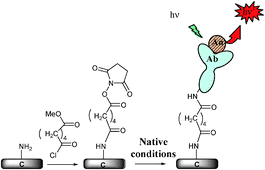Covalent immobilization of antibodies on electrochemically functionalized carbon surfaces
Abstract
A general method is described for the covalent attachment to carbon surfaces of sensitive biomolecules such as antibodies. First, N-hydroxysuccinimide-activated carbon surfaces are prepared by a step by step method involving an electrografting process and a monoprotected homobifunctional linker to ensure a good control of the surface modification. Then, antibodies are introduced, at the last step of the modification procedure, under native conditions at physiological pH, to minimize their denaturation. Comparison with a classical method involving a homobifunctional linker shows a decrease of the degree of coverage of the surface by antibodies, explained by the formation of bridged structures by the linker.


 Please wait while we load your content...
Please wait while we load your content...